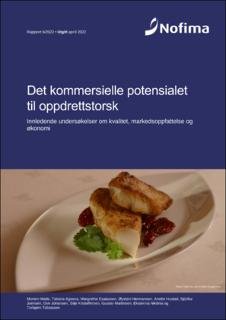By Wenche Aale Hægermark *
Norway – Norwegian enterprises are developing high-quality fermented fish sauces based on leftover raw materials. The market potential is huge. Fermented fish sauces are everyday products in Southeast Asia. Globally, the market is worth USD 15 billion. Nofima’s experts are contributing both technological and analytical expertise.
Noumami is the sole Norwegian producer of fermented fish sauces and currently uses salmon or cod in its sauces. In line with the goal of utilising fish better, it is aiming to expand its product range with a fish sauce made from pelagic fish offcuts.
All fish sauces are salty
As a rule, Asian fish sauces are made from fermented anchovies. They are important taste enhancers in many Asian dishes and have also been nicknamed ‘the chefs’ secret ingredient’. Developing a gourmet fish sauce from fermented herring offcuts requires knowing how to ensure consistent high quality and an understanding of the products currently on the market.
Salt is the most prominent taste in fish sauces, but other than that the variations between the different brands available today are fairly large.
Elisabeth Le, cookbook author and content creator for altasiatisk.no, is involved in the project and tasked with testing fish sauce varieties in dishes.
“Fish sauces are known for having a salty, permeating, strong aroma. As far as taste is concerned, I think of a good fish sauce as having a mild sweetness that balances out the salty taste of the sauce. The first taste to hit your tongue should be salt, but this should then be rounded off with a sweet aroma. The sweetness in fish sauces can help to achieve that good umami and caramelised taste in cooking, which is a prominent one,” says Elisabeth.
Other distinct tastes are shellfish, bouillon, soya, bitter and malt
Nofima’s sensory panel, which consists of ten taste judges, has tasted and smelled its way through ten different fish sauces. Seven of these were sauces found in supermarkets. Two of the remaining three were Noumami’s salmon fish sauce and cod fish sauce, and the final one was a sample from test production of the fish offcut sauce.
Stay Always Informed
Join our communities to instantly receive the most important news, reports, and analysis from the aquaculture industry.
“The various fish sauces taste quite different. All of Noumami’s sauces taste more of qualities associated with fish and bouillon than the sauces from the other producers. Most of the other sauces are described as having qualities such as bitter, roasted, sour, strong, malt, mushroom, cooking fat and rich. Some also have a more prominent taste of vegetables,” says Nofima researcher Mari Øvrum Gaarder. She heads the project’s research work.
Major aromatic differences
The sensory judges have sniffed their way to more than thirty different aromas. While some fish sauces offer hints of both cellars and cheese, others are closer to pungent fertiliser. A third dominant aroma is the aroma of vinegar.
“Noumami’s fish sauces in particular have a prominent aroma of vinegar. The Norwegian fish sauces from Noumami also offer hints of herring, fruit and caramel. The results from the first analysis indicate that these sauces have quite a different and milder aroma compared with those on the market today. Perhaps these will be better suited to the Norwegian palate?” speculates Mari.
A good fish sauce should be versatile
Given the fairly major sensory differences between the fish sauces tested by the taste panel, it was only natural to ask Elisabeth whether there are differences in how a fish sauce should taste depending on the dishes it is used in and whether it is common to use different fish sauces in different dishes.
When she grew up there were always two types of fish sauce at home and she believes that a good fish sauce for cooking should be versatile.
“The fish sauce should have a pleasant taste and aroma so that it is suitable for use in sauces, casseroles and salads, or as a dip. One type is darker, has been fermented for longer, and has a saltier taste for cooking such that the tastes are more prominent. The other is milder, lighter and sweeter and can be used concentrated without dilution for dips or diluted as a vinaigrette and as other sauces that will not be boiled. If you are going to have just one type, then I recommend the latter and instead adding more during cooking since the former can feel a little ‘strong’ on the tongue if it is served as a dip,” advises Elisabeth.
Contact person
Mari Øvrum Gaarder
Scientist
+47 64 97 03 18
mari.gaarder@nofima.no
Source: NOFIMA
Editor at the digital magazine AquaHoy. He holds a degree in Aquaculture Biology from the National University of Santa (UNS) and a Master’s degree in Science and Innovation Management from the Polytechnic University of Valencia, with postgraduate diplomas in Business Innovation and Innovation Management. He possesses extensive experience in the aquaculture and fisheries sector, having led the Fisheries Innovation Unit of the National Program for Innovation in Fisheries and Aquaculture (PNIPA). He has served as a senior consultant in technology watch, an innovation project formulator and advisor, and a lecturer at UNS. He is a member of the Peruvian College of Biologists and was recognized by the World Aquaculture Society (WAS) in 2016 for his contribution to aquaculture.



